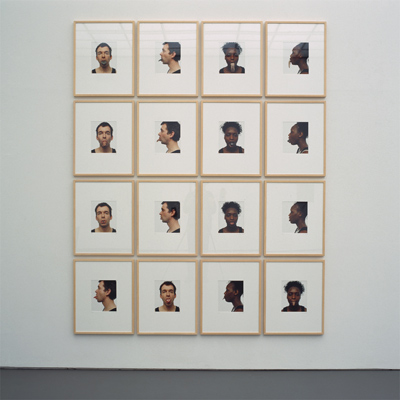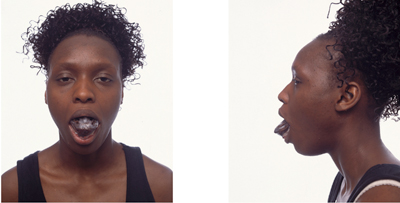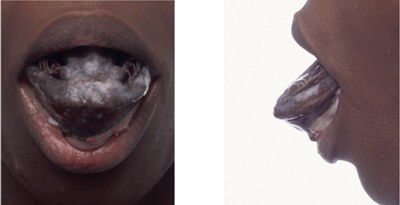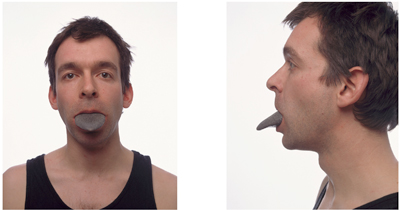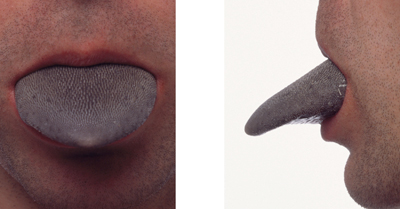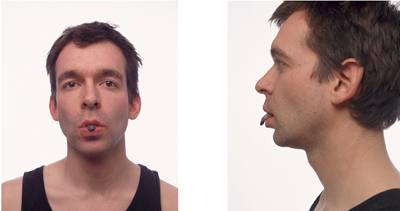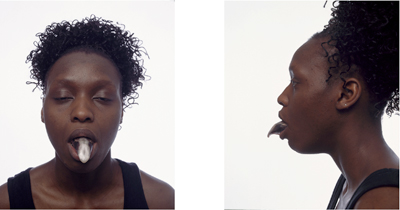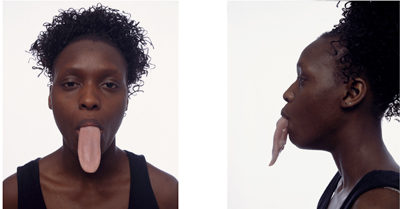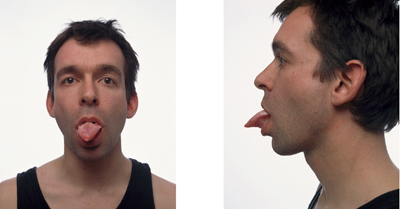The Tongued Tongues
The tongued tongues:
Anselmo Fox’s photographic serial La lingua della lingua
What do we see? Half length portrays in profile and front facial of a woman and a man poking their tongues out.
The tongues look oversized or strangely minimized and distort the human faces. They look embarrassing, grotesque and uncanny. They look as is if they did not belong to the human faces. And that is exactly what they do: Actually they belong to animals.
The Swiss artist Anselmo Fox plugged animal tongues in his own and a friend’s mouth and shot portrays.
The animal tongues are taken from several species: mammals, fish, birds, snakes. Or more precisely: ape, flamingo, king fish, leopard, maned wolf, sheep and white headed python. The tongues are inserted in an anatomically correct way: The tip looks out of the mouth, the root is hidden in the throat.
The portrays imitate the gesture of ‘showing the tongue’ which is in a Western cultural context mostly symbolic for dishonour and insult to someone. In other cultures the showing of the tip of the tongue can be a sign of respect and gratefulness. And also in Western discourse the tongue has got a positive connotation: It is protagonist of the passionate and fond kiss and performs the touch of ego and other. Thus the tongue is ambivalent.
Except these markers of social behaviour stretching out the tongue belongs to medical diagnostics nearly all over the world. In this medical tradition the tongue shows the general condition of the sick person and stands for the whole body. So the tongue appears as a place of insight and cognition.
We do not know, whether the photographic serial La lingua della lingua [The tongue of the tongue, 1999] is a photographic fiction of foreign tongues growing out of the human mouths, or whether it shows tongues penetrating the sensible oral cavity forcibly. And is it vague, whether the pictures show an usurpation of a strange body part by violence (i.d. an attempted annexation), or whether they show a friendly inclusion ( i.d. a temporarily intimate encounter). One more possibility: Maybe the portrays bring out the either proud or bashful presenting of an own internal alien.
The serial La lingua della lingua deals with the reality of a tongue plugged in and the internal fiction of a tongue struck out. Respectively it deals with the reality of a tongue choked in and the fiction of a tongue choked out.
The ambivalence of inside and outside persists: both are part of the reality of the tongue.
In La lingua della lingua something that usually is deeply hidden and firmly adnated in the mouth and represents a genuine internal part, approaches from outside. The tongues not only jut out of the mouth, they come from outside. They are foreign, they are animal.
Suspects
Whether the tongues are struck out or plunged in – in any case the photos portray persons carrying something uncanny or showing something uncanny from themselves. They show something, that makes them suspect.
That corresponds to the arrangement of the pictures: Every portray a front facial and a profile, the photos remind one of a rogue’s gallery. So the photos belong to a factual genre. Factual photography performs a concrete task in the social field. A rogue’s gallery is to give visual information about the delinquent’s appearance (without giving detailed information about the delinquency itself. In this sense there is free space for speculation and projection – and fiction –also in factual photography).
At the same time the photographs are portrays and hence belong to a traditional genre of art history. Portrays are the classical genre of representation, be the representation political or be it private.
Significant condition of portraiture is that representation does not only show what can be seen, but above all what shall be seen. Thus portrays exhibit much more fictional character than any factual photography and especially photography in criminological administration, which focuses the realistic recognizability of the portrayed person.
In La lingua della lingua factual and fictional attributes of photography overlap.
The photos in front facial and profile are strung objectively, diligently and systematically. The arrangement promises orientation and – for the maybe bemused and irritated observer – protection. Metaphorically spoken: The suspects are already optically detained. They are in-formed in the pictures, they are enframed and almost visually tamed.
At the same time the individuality of the faces vanishes behind the monstrous tongues, which is intended in criminological photography.
Portraiture is tied to individuality, be it fictional or realistic. As a general rule individuality is tied to the face. But as we can see, in La lingua della lingua the individuality of the portrayed person is rather controlled by the peculiarity of the different tongues, which are added to the faces, than by the appearance of the faces themselves.
And this action – adding an alien tongue to human faces – is a sculptural action.
Sculpturally spoken, the photos deal with the classical motif of a sculptor – the human exterior – in a new outlook, which shows a new face, or the face in a new perspective, or the interior of the face.
This is one of Anselmo Fox’s sculptural visions, that we can see in lots of his works: The inside seen in the outside.
Beyond the social implication of a rebellious or cheeky attitude or – conversely – of a grateful and respectful gesture in other cultures stretching out the tongue is in La lingua della lingua an artistic diagnosis and an aesthetical manifesto.
Lieu of the tongue, lieu of the kiss, lieu of insight, lieu of the art:
the mouth
Human and animal touch each other in the mouth, a place for transformation (of food) and transition (from the outside to the inside and the other way around), articulation and intimacy.
The serial portrays with the outstretched tongues show a snapshot of intimate contact between human and animal, live and death, inside and outside, which is reduced to a very special body part, that is eminently charged in cultural history: The oral cavity is a place of transition, where words are formed, articulated and vocalised, where food is chewed and prepared for digestion, and where transformation takes place. Whatever crosses the oral cavity changes its form.
This is also the case in the Transubstantiation in Christian theology: A verbal declaration of a priest changes the substance of host bread and sacramental wine into the substance of body and blood of Jesus Christ. Here the tongue is relevant in a concrete and a tropical sense: The believers take body and blood of Jesus Christ as the substance of bread and wine through the tongue. But bread and wine change into body and blood just by the sacralising eloquence (lingual competence) of the priest.
Anselmo Fox perceives the oral cavity as a place of sculptural action: Tongue and teeth form. The tongue is compacted place for any diagnosis of the body’s state, be it medical or be it aesthetical, as it is the case in Fox’s art.
So we can see the mouth as a place of aesthetical meaning in many of his art pieces:
Internal plastique impressions of French kisses between man and woman in the serial und ich ([and me], silicon sculpture, 1998-2007), internal plastique impressions of kisses between man and (again dead) animal, the chewing gum sculptures Eat mine slowly I (polymer, life-size, 1994) and Hava Atmak (life-size, 1996), bumping chewing gum bubbles Eat mine slowly II (video loop, super slow motion, 1994-96), chewing gum bubbles Im Windkanal ([In the wind tunnel] video, 1997), plastique impression of the sculptor’s bite in a bunch of grapes (without title, video, 2007). [Most of them can be seen in www.anselmofox.eu]
Traditionally sculptors work with their hands. The sculptor Anselmo Fox adds the grinding teeth and the pushing, scooping, gouging and spinning action of the tongue.
Thereby the tongue is an agile and versatile body part between inside and outside.
But the point is also the oral cavity. Fox takes this natural orifice of the body as a place of art.
Similar to the – naturally filled – eyehole, Fox presents the oral cavity as place and organ of perception and emergence of art. Fox opens the oral cavity, which is just a two dimensional flat with potential for the third dimension, while the mouth is closed. He straddles the oral cavity and fills it up with something, that is both natural and artificial: a foreign tongue.
As Fox uses not only biomorphic material but organic, he declares the oral cavity not only as meeting place of human and animal, but also of art and nature.
This declaration is like the religious Consecration a verbal and physical lingual act. (Of course Fox here plays with the modernist concept of the sacred art.)
And it is suggesting that La lingua della lingua alludes to the sexual acts of fellatio and cunnilingus.
Similar to a fellatio the lips surround a phallic, towering shape. Sculpturally spoken the oral cavity appears as a two-dimensional or three-dimensional space like the vagina. The tongue represents the phallus (this applies to the psychoanalytic and linguistic definition of the phallus by Jacques Lacan who declares the phallus as the “significant of desire” per se), as an image separated from from the Ego and supremely covetable. The separation from the mother’s body which the Freudian as well as the Lacanian psychoanalysis suggests as a primal trauma for any child, ends in the fear of loss and respectively – psychoanalytically spoken – the fear of castration. The separation from the mother’s body is effected by the loss of the breast as part-object, that is surrounded by lips of the sucking child. Mouth and desire belong together. Psychoanalytically the desire per se is the phallus. Thus mouth, tongue and phallus belong together. Thus the animal tongue plugged in the mouths of the portrayed persons is desire per se.
The tongue of language: Embodiment and incarnation
The tongue is the instrument of articulation, the mouth is place of the formation of language. So the tongue as a body part is corporal symbol of something, that is in general related with the human (so called civilized) sphere. Language is a marker of humankind. Language and tongue overlap semantically. In some languages, the word tongue and the word language have the same meaning, i.e. in English, in Russian ([yazyk]), in French (langue) and in Italian (lingua). The Italian title of the art piece La lingua della lingua can be translated as The language of the tongue or as The tongue of the language or as The tongue of the tongue or as The language of the language. Each of the translations would be deficient in a singular appearance. The full sense of the title is significant only in a combination of all translations.
But in German there is a difference between Sprache [language, tongue] und Zunge [tongue]. Sprache nowadays denominates a disembodied abstract term (and be the words as tender or as viperish as they can be). Sprache [language] in the acceptation of Zunge (tongue) in a concrete and tropical meaning is nowadays found only in anterior collocations or poetical application: in fremden Zungen sprechen (literally: to speak in strange tongues) and eine böse Zunge haben (to have a sharp tongue [literally: to have a bad tongue).
La lingua della lingua takes up residence in exactly this difference between (corporal) tongue and (abstract and symbolic) language. (That may be rooted in the artist’s biography: Anselmo Fox is native of the Italian part of Switzerland, but has been living for years in Berlin and Zurich and is fluent in Italian and in German.)
The tongue protruding from the human mouth is not only an animalistic foreign body, but – in the contrary – symbol of eloquence and cultural assets. Therefore the tongue is distinguishing marker of the human. And the tongue is symbol of that power, that is able to change. From one body into the other, from human into animal, from hate into love, from food into god.
But here, in La lingua della lingua, just this symbol, the tongue, is irritating and uncanny.
What comes out of the human mouth – what looks out of the human mouth and mocks the observer visually – is animal, not human. Is foreign and even alien.
Each living being is able to stretch out the tongue. Each small animal can do it, and each young child. But the animal tongues dismorph the human faces. Maybe this dismorphing points out the difference between animal and human. So La lingua della lingua is an anthropological statement: The demonstration of the human is animal. And the interior of the human is animal.
Amphibious, different: serpent, Leviathan
But maybe this art piece is also the realisation of a metaphor: to speak in strange tongues is age-old biblical and Babylonian metaphor of collective incomprehension. The foreign, inapprehensible language isolates men. Here the metaphor, the tropical meaning of the tongue – language – is traced back to its corporal origin.
This action of the reconnection of abstract concepts to the body has got a technical expression in contemporary cultural studies: embodiment refers to the homonymous concept of the cognition science, that any form of intelligence must have a physical correspondent. It is the body that finally tips the scales in any human expression.
In La lingua della lingua a foreign tongue looks out of the mouth, and this tongue is located between the portrayed person and the observer. So the tongue appears as embodiment, incarnation of the ‘between’ and the difference.
Difference as a philosophical concept is mostly defined in a structurally ontological way, not substantially. It appears as a grave nothing, as a semantically filled but substantially void gap between two poles.
But the animal tongues are clearly marked as substance. Maybe they are substance per se: they are flesh. And they are not only substance per se, they are embodiment per se. They are the incarnated difference.
The tongue is versatile between inside and outside, humid and dry, it is almost amphibious and related to the serpent not only by its form.
There is a nice French collocation: être une langue de vipèr [literally: to be a viper tongue, to have a sharp tongue]. In this collocation emerges the uncanny and the daemonic connotation of the tongue. It is no coincidence that the Biblical creature Leviathan from the Old Testament, who generated so many diabolic characters in literature and philosophy, is a monstrous being, living in the water and on earth.
Originally Leviathan was one of the seven princes of hell and the keeper of the hellmouth.
So the Tongue is leviathanic. Animal tongues plugging in the mouth, looming between human and animal and between human (portrayed) and human (observer) anyway.
The animal tongues are structural placeholder and incarnation of the difference between two faces (portrayed and observer) and they are fleshy substance.
Additionally here something is incarnated that comes from language respectively from linguistics:
The animal tongues perform a similar task like the word ‘and’. The word ‘and’ joins two objects together semantically, but it separates them substantially. While standing between two words, ‘and’ joins them together and separates them at the same time. It is conjunction and disjunction.
This is, what the animal tongues are. They are stuck between the human lips, between life (of the portrayed) and death (of the animal) and between concrete body and tropical language-game.
The oscillation collapses at that moment, when it becomes clear, that the incarnated difference is incorporation as well. Then embodiment is in-corpo-ration (German: Einverleibung) in the truest sense of the word.
The language of the tongue: incorporation
There is a cheerful parallel to a recent campaign of the German public trust for integration (Deutschlandstiftung Integration): Prominent immigrants promote integration by language acquisition. Big posters show them poking their tongues out. The tongues are painted with the German national colours black-red-gold (yellow). Under the photo of each of the prominent persons appears a slogan: “Raus mit der Sprache, rein ins Leben!” (Come on, out with it – into the life!). „Raus mit der Sprache“ can be translated literally as „Out with the tongue” (tongue in terms of language). “Raus mit der Sprache” is a colloquial German phrase. “Rein ins Leben” is an ardent calling for a good beginning of life. “Out with the tongue” means here “Out with the language” – and the prominent portrayed stretch their (physical) tongues out. Tongue and language are equalized with each other, as it is in other Indo-European languages, but usually not in German. Just the gap between abstract language and physical tongue makes this language-game possible.
From the perspective of the (native German) observer the persons on the posters are officially declared as immigrants, as former foreigners. But their tongues paradoxically belong to Germany because they wear the German colours. On the one hand tongues and tongue-strikers are obviously not familiar with each other, on the other hand the tongue-strikers point out, that they incorporated the tongues with the German colours and so appropriated them. They appropriated Germany by language acquisition (tongue acquisition). Actually one strikes out the own tongue – not a foreign.
La Lingua della lingua takes the „appropriation“ of the tongue literally: A foreign tongue is assimilated, incorporated, incarnated, embodied by the portrayed persons.
This may evoke a cannibalic association. The jolly language-game of the integration campaign quoting a cheeky gesture (and a famous Einstein portray), changes into the imagination of a brutal act of the consumption of the other.
But the other is animal, not human.
And as a symbol of language – and hence of humankind and civilisation – the incarnated tongue embodies hunger for culture and art.
The tongue of the tongue: The uncanny is the own
The cutting of the tongue was a typical corporal punishment during the middle age. Especially liars, defamers, blasphemers and traitors were cursed with it.
They say that the cutting of the tongue is still practised in mafia-like environment. There are cruel stories of torture, when the cut out tongue was stuffed back into the deliquent’s mouth. Double speechlessness: no single word can come out of a stuffed mouth, and a mouth without a tongue is not able to articulate.
The tongues in La lingua della lingua are foreign and cut.
Once more psychoanalytically speaking, the cut tongue symbolizes castration and castration anxiety. The tongues are tongues of dead animals, and there is nothing beyond of death and castration. Thus inside the mouth the most alien encounters the innermost.
(Preparing La lingua della lingua was much less brutal: Anselmo Fox found the animals tongues in the butchery, in the shop for fancy food of the KaDeWe (the big deluxe store in West Berlin) and in the animal pathology of the Berlin zoo. Before the fresh dead tongues were stuck into the human mouths they were dipped into grappa.)
The language of the language: the philosophy of grafting
Plugging the animal tongues into human faces is a sculptural action: plastiques are formed by addition of material. This aesthetical aspect makes plastiques from the portrays, which are at first sight just photos of humans with foreign tongues.
Hence the photos are representations of humans, who become living statues by the adding of foreign material – tongues.
In others words: The animal tongues are grafted into the human mouths. Grafting is a botanical and philosophical action as well. Botanical grafting is used in plant breeding: A foreign branch is implanted into the bole of a tree in order to improve the original plant. The French philosopher Jacques Derrida used the familiar terms greffe (French for graft) and graphe (French for character) to describe the action of reading in a deconstructive way: Reading and writing are both generated by grafting of already existing texts or text parts.
Both of the interpretations of the word grafting are similar to the plugging of the tongues into the human mouth: By adding a foreign thing a third party appears, a new being, a new image, a new version.
And – of course – the animal tongue sticks in the human mouth like a cork and a mechanical grafting.
The second tongue, the third ear and the third eye: Fox, Stelarc, Bilal
Anselmo Fox generates a hybrid of human and animal which does not present a taxidermically fabricated full-lenth chimaera, as it is too often practised and seen in contemporary sculpting. He focuses the enhancement of the human by adding something new and foreign.
This enhancement, represented in La lingua della lingua, is seldom but not singular in contemporary art. 2007 – eight years later than Fox’s tongue portrays – the Australian artist Stelarc had an implantation made of a third – artificial – ear. At first the implantation of the third ear was planned to be made into the face, in front of one of Stelarc’s own natural ears. The face represents the whole human being at Stelarc as well. The face is a pars pro toto. The additional ear was not intended to change a human face into a monster face, but was to become a third acoustic organ by the application of modern electro-technics. Fabricated from biomorphic material in technical laboratories, the artificial ear finally was affixed to the forearm, because the facial expression stresses the facial skin, which would have destroyed the artificial ear. The skin of the forearm is less stressed by moving. There the third ear was equipped with a microphone to send acoustic signals to the natural ears and hence upgrade the hearing.
(It is interesting that the new ear sends acoustic signals rather than receiving. Thus the new organ does not correspond to the natural ears which are always ready for receiving.)
We find another artistic implantation project in the last few months: 2010 the American photo artist Wafaa Bilal had made an implantation of a camera into the back of his head. The camera shoots one photo per minute, where ever Bilal finds himself. The project is to last one year. A new museum for contemporary art in Qatar was interested in Bilal’s specific way of photo shooting and promised to present a live stream of the pictures.
Similar to Stelarc’s implantation project it was difficult to find a legitimate hospital which admitted to the artistic grafting. Stelarc has been searching for a legitimate doctor for years, Bilal finally decided to make the implantation in a piercing studio in New York. One must admit, that the camera was plugged only under the scalp, not into the cranium. So we do not find an additional and artificially generated eyehole on the backside of Bilal’s head. In the traditional sense the added camera-eye makes a plastique from Bilal (not a sculpture).
This is different at Fox’s: Fox straddles the oral cavity widely. This is a natural action, but the oral cavity is not three-dimensional all the time. While the mouth is closed, it is a flat and folded body part just with potential for the third dimension. Fox caves the head for his photo serial and creates for the moment of the shooting a sculpturally hollowed throat, but immediately fills it up with the foreign small and large tongues: plastique. Thus Fox’s hybrids are both: human and animal, picture and statuary, sculpture and plastique.
It remains to be seen if the refusal of Stelarc’s and Bilal’s implantations was caused by medical ethos or by anthropologically rooted disgust, to graft organs and instruments into the human body, which are foreign to the species.
The irritation about Stelarc’s additional ear and Bilal’s third eye is similar to that in Fox’s La lingua della lingua. But the body extension in Bilal and in Stelarc are machine-like, while Fox works with true organic material. The third ear and the third eye are contrary to the organic human by its technical provenience and change the two artists into a kind of cyborg. Fox (posing with the animal tongues himself, like Stelarc and Bilal perform their art projects themselves) creates a temporary hybrid, which is made from precariously similar material to the human body.
Once more it remains to be seen, if Stelarc and Bilal had preferred true natural ears and eyes for their projects, if the lawful situation and the transplantation knowledge had allowed this.
In this case the fallback to dead mechanical technics would be just a kludge and the dream of the enlargement of capacities of the own body is going on. Then the hybrid from human and machine in Stelarc and Bilal would be a perished half-way state.
At least this may be the case in Stelarc, because he wants to hear. Bilal in contrast wants to document, what he can see at this place, where he normally cannot see: in behind.
Protom. Protomé. Prosthesis
Ethnologically or ethno-sociologically speaking, the idea of the enhancement of the body in order to enlarge its capacities is familiar to shamanic practices in different cultures. Belongings of a foreign domain – i.d. animals or the opposite sex – are added to the own domain in order to enlarge the shamanic skills. Ethnology calls such a functionally fixed object – be it a thing or a body part – protom.
The animal tongues in Fox’s La lingua della lingua in this sense appear as protom, as enlargement of the human body by animal capacities and by one part of life, that actually does not belong to the sphere of life: death.
The photos present a transitional and liminal situation as it is also marked by the phase of birth, initiation, vision, illness and dying.
The appropriation, incorporation and grafting of the non-related tongues does not appear as impairment or dilution of the own in this version, but as augmentation – unlike the psychoanalytical interpretation of the phallic and lingual symbolism does when it brings up the categories of (castration) anxiety and separateness.
Terminologically related to protom is the ancient Greek protomé, which can be translated as ‘animal face’. Protomé denotes a decoration of equipment or architecture with pictures of animal faces. These reliefs on immobile facades and portable instruments may be fixed there not only to decorate something, but to banish gatecrashers or thieves – like the outstretched tongue.
As a genre of art, reliefs are in between of sculpting and painting.
Fox’s La lingua della lingua is also in between of two genres: The portrays are photos, but based on sculptural and plastique procedure in the truest sense: Fox adds material to portray people in their individuality and therefore spreads the oral cavity widely. One more liminal position.
In this sense Stelarc’s third ear and Bilal’s third eye are not protomical, for their corporal enhancement of capacities proceeds absolutely prosthetically: technical assistance for the body.
Documents
The arrangement of the photos quotes criminological archives and data files. But La lingua della lingua does not present mug shots, but already assorted and identified aesthetical facts.
The vision of a new sculpting, which does not only deal with inside and outside but which contrasts the sculpting hand and measuring eye with the tooth, the tongue and the mouth as aesthetically relevant body parts. This vision is no longer searched for. It is already documented. The fiction is a representative fact.
Work/photography by Anselmo Fox, 1999, Berlin, Germany
Text by Mirjam Goller, 2011, Berlin, Germany
The Tongued Tongues
RELATED WEB SITE
→ artist’s web-site
[ CITRACIT ]
[ I am home ]
[ Narrations of Flights ]
[ Oblique ]
[ Palestinian Dictionary ]
[ Pilgrimages ]
[ Post Mortem ]
[ Sound Tracking ]
[ The Hours that Hold the Form (A Couple of Days in Portbou) ]
• The Tongued Tongues •
FEATURED THEME ON CITY SHARING
by ASUNCION MOLINOS GORDO
-
This project is an instrument for common critical analysis to help understand the reasons behind Egyptians’ diminishing …
by INAS HALABI
-
The project Letters to Fritz and Paul focuses on the expeditions of the Swiss cousins, lovers and scientists, Fritz and …
by SARAH BURGER
-
The planned modern city of Brasilia attracted me since a long time. Her defined shape, location and function proceded he …
by ADRIEN GUILLET
-
Youri Telliug talks with the artist Adrien Guillet about his project Citracit
Youri Telliug - What is Citracit …
by NIGIST GOYTOM
-
In 2013 more than 45 million people have been forced to leave their homes. This amounts to the biggest number of refugees …
by SULAFA HIJAZI
-
The on going debate on Arab identity and its (cultural) representation is strongly shaped by Edward Saidʼs formative …
by ASUNCION MOLINOS GORDO
-
WAM is a site-specific work that uses the historical trope of the cabinet of curiosities to explore the introduction of …
MORE CONTRIBUTIONS BY THE FOLLOWING
